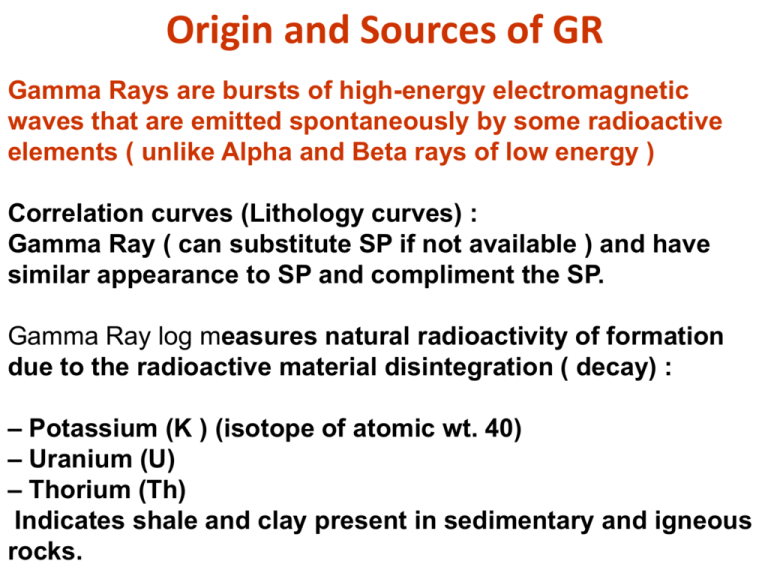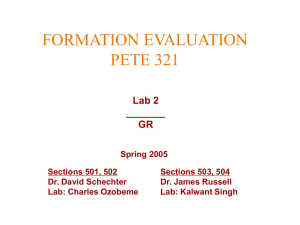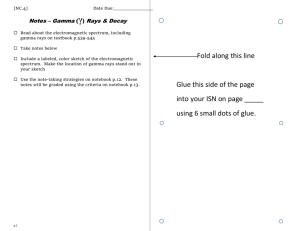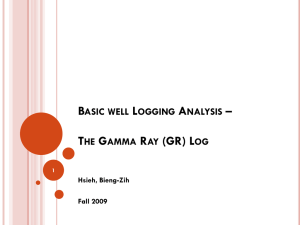Gamma Ray Log
advertisement

Origin and Sources of GR Gamma Rays are bursts of high-energy electromagnetic waves that are emitted spontaneously by some radioactive elements ( unlike Alpha and Beta rays of low energy ) Correlation curves (Lithology curves) : Gamma Ray ( can substitute SP if not available ) and have similar appearance to SP and compliment the SP. Gamma Ray log measures natural radioactivity of formation due to the radioactive material disintegration ( decay) : – Potassium (K ) (isotope of atomic wt. 40) – Uranium (U) – Thorium (Th) Indicates shale and clay present in sedimentary and igneous rocks. Statistical Variation phenomena • GR emittion is not at constant rate and speed, but at random, because it is a natural phenomena. Thus, logging speed should be slow to reduce this effect. GR Log Measuring Equipment • GR sonde contains a detector to measure Gamma radiation originating in the volume of the formation near the sonde. • They are two types: – Geiger Mueller counters : used in the pasts – Scintillation counters : now used for this measurement; they are much more efficient than the Geiger Mueller counters used in the past, and they offer good formation detail. Origin and Sources of GR, cont • Radioactive elements tends to concentrate in shale and clays due to their structure and origin. • Clean formation usually have very low level of radioactivity, unless local radioactive contaminants such as volcanic ash or granite wash or organic matter is present, or formation waters contain dissolved radioactive salts. Gamma Ray Log ; uses •Gamma ray log is measurement of natural radioactivity in formation verses depth. •It measures the radiation emitting from naturally occurring U, Th, and K. •It is also known as shale log and as shale indicator. •GR log reflects shale or clay content. •Clean formations have low radioactivity level. •Correlation between wells, •Determination of bed boundaries, and sand count. •Evaluation of shale content within a formation, •Mineral analysis, •Depth control for log tie-ins, side-wall coring, or WO, perforating and completion. •Used in tracer emitting and detection as in WI, GI, cementing . •Particularly useful for defining shale beds when the sp is featureless. •GR log can be run in both open and cased hole 1 µ gm Ra-eq / Ton = 16.5 γAPI unit Gamma Ray Log Uses • Generally, a gamma ray log indicates the amount of shale present • Low Natural Radioactivity – – – – Sandstone Limestones Dolomites Minimum reading at salt & anhydrite ( few API units) • High Natural Radioactivity – Shales, Mica , Feldspar, Volcanic, and NORM • Gamma ray logs can be run in both openhole and casedhole environments. • Although the overall reading of the gamma ray is affected by the casing, the character of the log is not so that the cased-hole gamma ray can be used to correlate with the openhole gamma ray. Gamma Ray Log & NGS *Standard gamma ray logs measure the total natural radioactivity of a formation. *Information from cased hole logs: - Gamma Ray Log - same as open hole log; *Natural Gamma Ray Spectrometry Log used to identify clay types and clay volumes, and is a better shale indicator than GR; *The standard gamma ray log can be used to calculate the fraction of the reservoir that is shale by using a straight line calculation Gamma Ray Log & NGS *Standard gamma ray logs measure the total natural radioactivity of a formation. *Special gamma rays logs called spectral gamma rays can determine separately the amount of gamma rays from potassium, uranium, and thorium. Although these logs are not commonly run, they are often useful for the geologist when trying to correlate various shales. *The standard gamma ray log can be used to calculate the fraction of the reservoir that is shale by using a straight line calculation. Gamma Ray and Caliper logs Correlation Gamma Ray and Caliper logs Correlation Gamma Ray and Caliper logs Correlation Gamma Ray, SP, and Caliper logs Correlation Vsh (shaliness Calculation) Vsh Estimation from Gamma Ray Vsh Estimation from Gamma Ray Units For one type of tool, the relationship between the concentration of the three radioactive components and the total gamma ray signal in API units (γAPI ) is given approximately by: γAPI = 4 Th + 8 U + 16 K when thorium (Th) and uranium (U) are measured in ppm and potassium (K) in percent by weight. 1 µ gm Ra-eq / Ton = 16.5 γAPI unit




